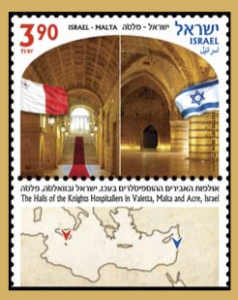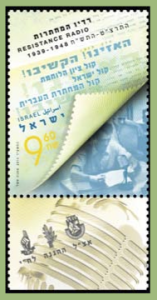Joint Issue Israel – Malta
January 28, 2014
From Israel Post:
 The year 2014 marks 50 years of diplomatic relations between Israel and Malta. Israel, which was still a young country when relations were established in 1964, shared the knowledge and experience it accrued during its 16 years of independence with Malta.
The year 2014 marks 50 years of diplomatic relations between Israel and Malta. Israel, which was still a young country when relations were established in 1964, shared the knowledge and experience it accrued during its 16 years of independence with Malta.
The relationship between these two peoples is ancient and special: friendly and cooperative relations between the Jewish people and the Phoenicians, the ancient inhabitants of Malta, were mentioned in the Bible – the Book of Books, which is extremely significant to both peoples.
There was apparently already a Jewish community in Malta before the Christian era and during the Middle Ages it is estimated that Jews made up approximately one third of the population of Mdina, which was the island’s capital at that time.
The heroic efforts by Malta’s residents in resisting the Nazi enemy and their proud stance in face of heavy bombings and siege were warmly appreciated by the Jewish Yishuv in Eretz Israel, many of whom took part in the fight against the Nazis who annihilated one third of the Jewish people during the Holocaust.
The two countries share a commitment to democracy and democratic values, as well as the same parliamentary system and they are also similar culturally, geographically and linguistically.
Relations between the two countries and their peoples continue to flourish in the areas of trade, technology, science, energy, culture and tourism.
The Order of the Knights Hospitallers, also known as the Order of the Hospitallers of St. John of Jerusalem, developed in Jerusalem in the early 12th century around the church hospital building located south of the Church of the Holy Sepulchre. Members of the Order swore to dedicate their lives to helping Christian pilgrims who came to Jerusalem during the Crusader period, to provide them with medical care and to protect them from bandits and attackers along their route. In 1187, following the Crusader defeat in the Battle of Hattin, the Hospitallers were forced to leave Jerusalem and moved to Acre.
The city of Acre served as the capital of the Crusader kingdom from 1191-1291. The city was divided into quarters which were inhabited by the military Orders (the Hospitallers, the Templers and the Teutonics) and the Italian commercial communes. Each of these groups built grand buildings within its own area, reflecting Acre’s status as one of the most important cities in the world at the time. The Knights’ Halls built by the Hospitallers in Acre were unearthed in archeological excavations and have become a popular tourist site.
The most impressive building in the complex is the Order of the Knights Hospitallers’ dining room (the refectory). Its domes and arches intersect in the gothic style that developed in France and Italy in the 12th century and also appeared in Acre during that period.
In 1291, Acre was conquered by the Mamluks, led by Kalavun, and completely destroyed. The Hospitallers resided in Cyprus for some 20 years until they conquered the island of Rhodes from pirates in 1310, and there established their center. They fortified the island, defending it against Muslim attacks, and lived there for some 200 years until they were forced out by the Turks.
In 1530 the Hospitallers were granted control of the island of Malta by Roman Emperor Charles V and founded a sovereign state. The members of the Order, led by Jean Parisot de Valette, were widely praised when they successfully prevented Malta from being conquered and withstood the lengthy siege the Turks imposed upon the island.
After driving out the Turks, the Hospitallers founded a new city called Valletta, in honor of their leader, where they constructed a series of magnificent buildings. On the edge of the city, overlooking the Port of Valletta, they built a sophisticated hospital where dedicated members of the order treated hundreds of wounded and ill. Today the building serves as the Mediterranean Conference Centre, which can accommodate 1400 visitors in modern halls that preserve a sense of the past.
Description of the Stamp and the First Day Cover:
The stamp: on the right – the Hospitallers’ refectory in Acre (photograph: www.goisrael.com); on the left – one of the halls in the Hospitallers Hospital in Valletta. The first day cover: on the right – a section of the sea wall in Acre (photograph: Shutterstock); on the left: a section of the port fortifications in Valletta.
“The first joint issue of the year takes us back in time and conjures up dreams of Knights in shinning armor! This joint issue with Malta depicts the Halls of the Knights Hospitallers found both in Acre and Valetta.” — Mrs. Yael Koskas, International Marketing Manager, Israel Post





